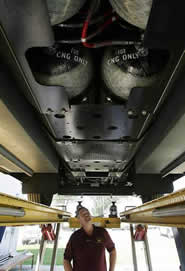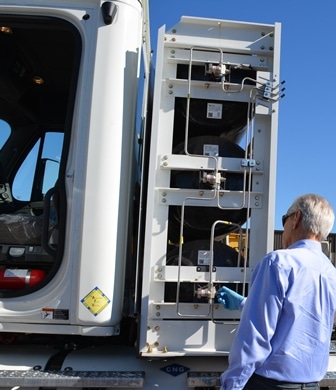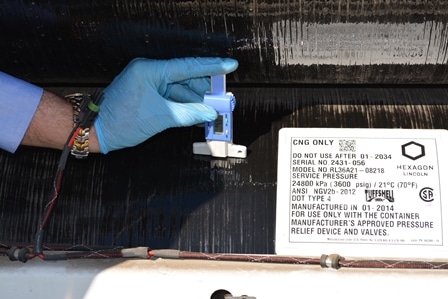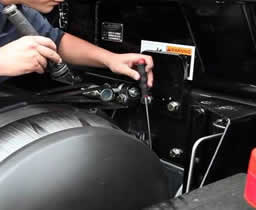By Annalloyd Thomason, Vice President/General Manager, NGVi

The Confusion About CNG Fuel System Inspections
Responses to CNG fuel system inspection requirements are all over the map. Many NGV users aren’t even aware that fuel system inspections are necessary. Others argue that inspections just “aren’t that big a deal.” Most don’t understand the real reason why they are necessary beyond the fact that they are recommended/required by regulations or standards. And countless others have no idea the high degree of risk management their companies place in the hands of technicians who are responsible for performing the inspections.
The Importance of CNG Fuel System Inspections
CNG fuel system inspections are necessary, required and important because natural gas is stored onboard CNG vehicles at extremely high pressures—at least 3,600 psi. While CNG fuel systems are extremely safe due to their rigorous manufacturing, testing and installation standards, if a fuel system is fully pressurized and a component has been installed incorrectly, damaged or otherwise compromised, the result can be severe injury or loss of life–preventable injury or loss of life.
Codes, Requirements, Regulations or Law?
In 1992, the NGV industry first published NGV2, a voluntary industry manufacturing standard for cylinders (ultimately integrated through the American National Standards Institute (ANSI) standards process) which included an in-use inspection interval. NGV2 states that “Each container shall be visually inspected at least every 36 months, or at the time of any re-installation, for external damage and deterioration…”

Subsequently in 1995, the National Highway Transportation Safety Administration, within the U.S. Department of Transportation, published a similar manufacturing standard (FMVSS 304) that also included an end-user inspection interval that is slightly different. FMVSS 304 states that CNG containers “should be visually inspected after a motor vehicle accident or fire and at least every 36 months or 36,000 miles, whichever comes first, for damage and deterioration.”
One of the problems is that both of these standards are manufacturing standards, and the federal standard (FMVSS 304) that would seem most like “law” uses the phrase “should be visually inspected,” not the “shall” word that usually accompanies a regulation or law. Add to that the fact that both NGV2 and FMVSS 304 “require” inspection of the cylinders, and not the entire fuel system, while industry best practice (and the CSA Group CNG Fuel System Inspector Certification process) calls for inspection of the high-pressure portion of the CNG fuel system—not just the cylinders, and there’s room for a lot of confusion.
Enter the Heavy-Duty CNG Truck Challenge
Due to their high annual mileage, many heavy-duty CNG trucks require CNG fuel system inspections every 11-13 weeks. The affected heavy-duty fleet operators find this requirement to be inconvenient and expensive, and as a result, at least two fuel system manufacturers have offered documents allowing a one-year/100,000 mile inspection interval. However, because FMVSS 304 is treated as a regulation, many end-users are unwilling to adopt the revised standard due to the potential risk. The thought principle goes like this: If there is litigation following an incident involving a CNG fuel system where the inspection interval or process is in question, and the vehicle owner did not adhere to the 3 year/36,000 mile inspection interval found in FMVSS 304, what is the likelihood that the courts would give a pass to the vehicle owner because they did not follow the most commonly adhered to standard. It’s a hypothetical scenario, for sure, but one that crosses the minds of fleet managers every day.
The NGV Industry Is Trying to Address the Challenge
Over the past several years, representatives of NGVAmerica and the Clean Vehicle Education Foundation have met with NHTSA to begin a dialog about revising the FMVSS 304 standard. A few years back, the reported result of a NHTSA meeting was that NHTSA told the industry to “go back to the manufacturers” to get resolution. However, because FMVSS 304 is treated like a federal regulation, many cylinder manufacturers have indicated they will not revise their requirements until NHTSA/FMVSS 304 blesses the move. And there you have a circular problem.

In the past few weeks, a renewed effort has been made between NGV industry representatives and NHTSA, with a meeting to open another conversation regarding inspection intervals. It was reported that the meeting went well and at least put the discussion on the table (again), but government is not known for its speed and in my opinion, the process of changing the intervals through NHTSA will be a slow one.
Other Solutions on the Table
It has been suggested that to solve the problem expediently, heavy-duty trucking advocates should approach another U.S. Department of Transportation entity—the Federal Motor Vehicle Carrier Safety Administration (FMVCSA)—to seek their approval of the adoption of a one-year/100,000 mile inspection interval. The logic behind this suggestion is that FMVCSA already requires an annual inspection and that the CNG fuel system inspection could/should become another element of that inspection. Opposition to this suggestion comes in the form of concern that the required level of knowledge by FMVCSA regarding CNG and CNG fuel systems—including cylinders—would be high and that in general, federal agencies do not get that deep into what might seem like a “specialty” subject.
So in the Meantime…
In the meantime, heavy-duty fleet managers are developing solutions to the need for frequent CNG fuel system inspections based on their company’s risk tolerance. Most of NGVi’s clients have decided to adhere to the three-year/36,000 mile inspection interval, but have worked with us to help them streamline the CNG fuel system inspection process for their specific vehicles.

Providing effective training for technicians—and providing that training using the actual fleet’s vehicles—can go a long way towards reducing the inspection time. And speaking of training, the safety of any CNG fleet is only equal to the knowledge and skill of the technicians performing inspections. Companies cannot afford the risk of an untrained or poorly trained inspector—whether that inspector is an employee of the company or a third party.
Looking forward, it seems that CNG fuel system inspection intervals for heavy-duty trucks may be increased. Where the responsibility for that decision winds up is anybody’s guess.
